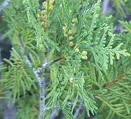Pacific Redcedar Tree Information
Images of Pacific Redcedar:






Pacific Redcedar grows in the following 9 states and provinces:
Alaska, Alberta, British Columbia, California, Hawaii, Idaho, Montana, Oregon, WashingtonInformation about Pacific Redcedar:
The Thuja Plicata is commonly known as the Arborvitae, Canoe-cedar, Giant Arborvitae, Giant Redcedar, Pacific Redcedar, Shinglewood, Western Red-cedar as well as Western Redcedar.
The currently accepted scientific name for western redcedar is Thuja plicata Donn ex D. Don . It is a member of the Cypress family (Cupressaceae). Western redcedar hybridizes with Thuja standishii. Hybrids are resistant to the leaf blight caused by Didymascella thujina . There are no recognized subspecies, varieties, or forms.Western redcedar occurs along the Pacific Coast from the southern part of the Alaska Panhandle through British Columbia, western Washington, and western Oregon, reaching into the coastal redwood forest of northern California . Inland from the coast it occupies a contiguous band east of the Cascade Range from central Oregon to southern British Columbia . Much farther inland a disjunct population occurs along the west slopes of the Rocky Mountains from Prince George, British Columbia, to northeastern Washington, northern Idaho, and western Montana .Western redcedar commonly occurs as a dominant or codominant on low-elevation moist sites. In Montana, the western redcedar habitat type series described by Pfister and others occurs most extensively in the Swan Valley and Mission Range, extends eastward locally to Missoula, and forms small riparian stringers along major streams in the Bitterroot Range west of Hamilton. Western redcedar occurs as a riparian dominance type on toe-slope seepages, moist benches, and wet bottoms adjacent to streams . Daubenmire and Daubenmire recognized three western redcedar communities in northern Idaho. Western redcedar/pachistima (Pachistima myrsinites) is an upland community, while western redcedar/Devil's club (Oplopanax horridum) and western redcedar/ladyfern (Athyrium felix-femina) occur on bottomlands. Western redcedar is sometimes found as a codominant with western hemlock (Tsuga heterophylla) . Published classifications identifying western redcedar as a dominant or codominant are as follows: Oldgrowth forests of the Canadian Rocky Mountains National Parks . Preliminary plant associations of the southern Oregon Cascade Mountain Province . Classification and management of riparian and wetland sites in northwestern Montana . Forest habitat types of northern Idaho: a second approximation . Forest Vegetation of eastern Washington and northern Idaho . Fire ecology of Lolo National Forest habitat types . Preliminary forest plant association management guide. Ketchikan area, Tongass National Forest . Fire ecology of western Montana forest habitat types . A guide to the interior cedar-hemlock zone, northwestern transitional subzone (ICHg), in the Prince Rupert Forest Region, British Columbia . Riparian dominance types of Montana . Classification and management of riparian sites in southwest Montana . Soil classification as an aid to identifying forest habitat types in northern Idaho . Forest habitat types of Montana . Reference material Daubenmire habitat types . Preliminary forest plant associations of the Stikine area, Tongass National Forest . A study of the Vegetation of southeastern Washington and adjacent Idaho .Some of the information provided here is attributed to:Tesky, Julie L. 1992. Thuja plicata. In: Fire Effects Information System, [Online]. U.S. Department of Agriculture, Forest Service, Rocky Mountain Research Station, Fire Sciences Laboratory (Producer). , available at the USDA Fire Effects Information System (FEIS) website